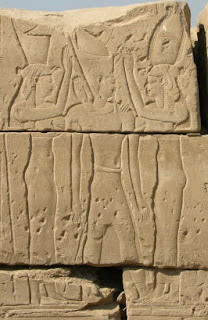 Hatshepsut being crowned by Amun-Re and granted life and dominion by the goddess "Great in Magic", from the reconstructed Red Chapel in the Karnak Open Air Museum. An early 18th Dynasty temple at Mut dates to the reign of this woman who ruled as king.
Hatshepsut being crowned by Amun-Re and granted life and dominion by the goddess "Great in Magic", from the reconstructed Red Chapel in the Karnak Open Air Museum. An early 18th Dynasty temple at Mut dates to the reign of this woman who ruled as king. "God's Wife of Amun" was an important female priestly title in Thebes. In the 1st millennium BC it was usually held by a sister or daughter of the reigning king, each God's Wife adopting her successor. They became so powerful that they were able to have themselves represented in roles normally played by the king.
 In scenes of goddesses suckling humans, the human is normally the king, with the scene representing the transfer of life and power. Yet in this scene in the Chapel of Osiris-Ruler-of-Eternity at Karnak, not only is the God's Wife of Amun, Shepenwepet I, being suckled, she is also wearing 2 Double Crowns, something shown nowhere else in any period.
In scenes of goddesses suckling humans, the human is normally the king, with the scene representing the transfer of life and power. Yet in this scene in the Chapel of Osiris-Ruler-of-Eternity at Karnak, not only is the God's Wife of Amun, Shepenwepet I, being suckled, she is also wearing 2 Double Crowns, something shown nowhere else in any period.
 In her funerary chapel at the temple of Medinet Habu, Amunirdis makes offerings to Amun and Hathor. The presence of funerary chapels to mortals within the sacred grounds of a temple is rare until the Third Intermediate Period, a time when God's Wives of Amun flourished.
In her funerary chapel at the temple of Medinet Habu, Amunirdis makes offerings to Amun and Hathor. The presence of funerary chapels to mortals within the sacred grounds of a temple is rare until the Third Intermediate Period, a time when God's Wives of Amun flourished.
 Intangible concepts could also be represented as goddesses. In a scene commemorating an important military campaign by Sheshonq I of Dynasty 22, the goddess "Victorious Thebes", carrying a mace, an axe and a bow, drags conquered cities (shown as bound prisoners with the city names enclosed in cartouches representing fortified walls) to be slaughtered.
Intangible concepts could also be represented as goddesses. In a scene commemorating an important military campaign by Sheshonq I of Dynasty 22, the goddess "Victorious Thebes", carrying a mace, an axe and a bow, drags conquered cities (shown as bound prisoners with the city names enclosed in cartouches representing fortified walls) to be slaughtered.
 Upper and Lower Egypt were represented as the goddesses Nekhbet (right) and Wadjet. Scenes of the king flanked by these protective deities are common in all periods of Egyptian history. This one comes from the Mut Precinct's Ptolemaic Chapel D.
Upper and Lower Egypt were represented as the goddesses Nekhbet (right) and Wadjet. Scenes of the king flanked by these protective deities are common in all periods of Egyptian history. This one comes from the Mut Precinct's Ptolemaic Chapel D. Keeping Mut and Sakhmet happy was a main function of the Mut priesthood. In this scene from the Mut Precinct's main entrance the king (holding Hathor-headed sistra) and two priestesses play music to Mut and Sakhmet to amuse them and keep them contented.
Keeping Mut and Sakhmet happy was a main function of the Mut priesthood. In this scene from the Mut Precinct's main entrance the king (holding Hathor-headed sistra) and two priestesses play music to Mut and Sakhmet to amuse them and keep them contented.
Two busts of Sakhmet in the Mut Precinct. Sakhmet angered could release disease and disaster on Egypt. Contented she could control these forces, which is why she is a goddess of health and healing as well as of death and destruction.



These 3 reliefs of Mut span a period of several hundred years. On the left is a relief from Amunirdis's funerary chapel at Medinet Habu; in the center a relief from the chapel of Osiris-Ruler-of-Eternity at Karnak; and on the right a relief in Chapel D at the Mut Precinct. In all three scenes Mut appears in her usual guise of a human wearing the Double Crown.
 And finally, a stela of a king offering to Mut that we uncovered in 2006. While the stela is uninscribed, it is entirely possible that it dates to the reign of the Roman Emperor Tiberius, showing that Mut continued as an important goddess even after Egypt's conquest by Rome.
And finally, a stela of a king offering to Mut that we uncovered in 2006. While the stela is uninscribed, it is entirely possible that it dates to the reign of the Roman Emperor Tiberius, showing that Mut continued as an important goddess even after Egypt's conquest by Rome.Richard Fazzini
Director, Mut Expedition





